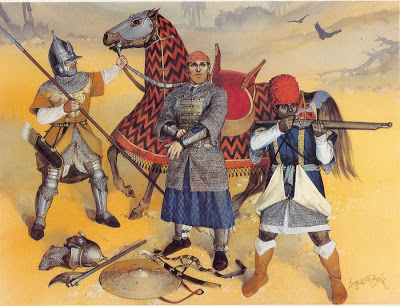 |
| Egyptian Mamluk warriors serving in the Ottoman Empire in the 16th century. Image from The Lost Treasure Chest. |
A people’s history:
The movement to democratize Egypt
Part 2: 641-1805 period — Egypt under many rulers.
By Bob Feldman | The Rag Blog | July 11, 2013
[With all the dramatic activity in Egypt, Bob Feldman’s Rag Blog “people’s history” series, “The Movement to Democratize Egypt,” could not be more timely. Also see Feldman’s “hidden history” of Texas series on The Rag Blog.]
Egypt became part of the Islamic Arab Empire in 641 when Arab armies replaced Egypt’s Byzantine Empire rulers “thanks in part to aid from the indigenous [Egyptian] population of Coptic Christians,” according to Egypt from Independence to Revolution, 1919-1952 by Selma Botman.
But the indigenous Coptic Christians in Egypt eventually became a religious minority, as Egypt was Arabized and Islamized. And by 834 Egypt was an autonomous state of the Baghdad-based Islamic Arab Empire, which generally permitted it to be ruled by a locally-based elite of Turkish ethnic background.
In 969, however, the religious leaders of a Tunisia-based Shiite Islamic sect, the Fatimids, moved their troops into Egypt from western North Africa, started construction of the new city of Cairo and began ruling Egypt until 1171.
Between 1171 and 1250, Sunni Islamic religious leaders next ruled Egypt. And then, between 1250 and 1517, the Mamluks — a military dynasty of former soldier-slaves of mostly ethnic Turkish or Caucasian origin — were the rulers of the autonomous state of Egypt. And it was during the period when the Mamluks controlled Egypt that the bubonic plague spread from Europe to Egypt in 1347; and, by 1349, the plague had caused the death of 33 percent of the people who had lived in Egypt in 1347 and damaged the economic base of the Mamluk regime.
Then, in the 15th century, “another serious blow to the Mamluk economy came…when the Portuguese found the ocean route around Africa, providing Europe with a direct connection to India, the Far East, and the east coast of Africa, disrupting the Mamluks’ lucrative Red Sea trade and diminishing the importance of Egypt as a commercial connection between the Mediterranean and the Red Sea,” according to Jason Thompson’s A History of Egypt.
But after the better organized, more disciplined, more numerous, and better-armed troops of Turkey’s Ottoman Dynasty defeated the Mamluk forces in the August 1516 Battle of Marj Dabiq in Syria and marched into Egypt in 1517, Egypt became a subject Arab province of Turkey’s Ottoman Empire for most of the next 400 years.
Yet as The Rough Guide To Egypt observed, “even after the Turkish conquest, the Mamluks remained powerful figures in the administration of what was now a province of the Ottoman Empire” and “the Mamluk army continued to grow with the import of Caucasian slaves.”
According, to A History of Egypt:
One can speak of a neo-Mamluk system that prevailed within Ottoman Egypt… The neo-Mamluks…quickly reinserted themselves into Egypt’s overall military establishment and again became the most powerful force in the land….. The Ottomans basically kept the commanding heights under their supervision, but left many administrative tasks to…religious endowments, or waqfs… About 20 percent of the land was religiously held by the end of the 18th century. The Mamluks…continued to control much of the rest.”
As a province of the Ottoman Empire, Egypt was exploited as a “breadbasket” and a “land tax” source for the Turkish imperial government’s treasury; and “Egypt also provided a valuable base for Ottoman operations in the Red Sea,” according to the same book.
But between July 1798 and September 1801, Napoleon’s French troops temporarily occupied Egypt until UK troops and Ottoman troops jointly recaptured Egypt for Turkey’s Ottoman Empire in 1801. A new local ruler, a Turkish military officer named Muhammad Ali, was then appointed as viceroy/governor/pasha of Egypt by the Turkish government in Istanbul in July, 1805; and the royal dynasty in Egypt which he founded governed Egypt — usually as puppet rulers for foreign imperialists — until 1952.
[Bob Feldman is an East Coast-based writer-activist and a former member of the Columbia SDS Steering Committee of the late 1960s. Read more articles by Bob Feldman on The Rag Blog.]

















